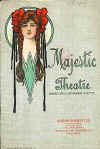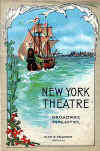Demolished Broadway Theatres - M to O
Compiled by John Kenrick
(The images below are thumbnails – click on them to see larger versions.)
- Madison Square Theatre
- Majestic (1st - 58th Street)
- Manhattan
- Maxine Elliott's
- Mechanic's Hall
- Henry Miller
- Morosco
- Nassau Street
- National
- Nazimova's 39th Street
- New
- New Century
- New Park
- New York
- New Yorker
- Niblo's Garden
- Nora Bayes
- Norworth
- Olympic (1st)
- Olympic (2nd)
Madison Square Theatre
- see Fifth Avenue
 Majestic
Majestic
Broadway and 59th Street, at Columbus Circle
Later named: Park, Cosmopolitan, International
Built: 1903
Demolished: 1954
Seats: 1,704
Architect: John H. Duncan
History: Built by the Pabst Brewing Company as part of an entertainment
complex. Renamed The Park in 1911,
then the Cosmopolitan in 1922 and The International
in 1944, it was used as an NBC television studio from 1949 until its demolition
in 1954 – Sid Caesar's variety series Your Show of Shows was broadcast
from here.
Noteworthy Musicals: The Wizard of Oz (1903), Babes in Toyland
(1903), The Rose of the Alhambra (1907), The Quaker Girl
(1912), Sing Out Sweet Land (1944)
Manhattan
- see Standard
Maxine Elliot's
107 West 39th Street
Built: 1908
Demolished: 1956
Seats: 934
Architect: Marshall & Fox
History: Named for a popular actress, this was the first theatre
built by the Shubert Brothers in the Times Square area. Ms. Elliott
managed the house through 1920, after which it had few successful tenants.
From 1941 onwards, it was used as a radio and television studio.
Mechanic's Hall
472 Broadway
Also named: Butler's American Theatre
Built: 1847
Demolished: 1868 (fire)
History: For its first ten years, this theatre housed E.P.
Christy's Minstrels, then the most popular minstrel troupe in New
York. The Bryant Brothers Minstrels followed (1857-1865), as did
other troupes. Renamed Butler's American in 1867, the building
burned down less than a year later.
Henry Miller
124 West 43rd Street
Alternate name: The Kit Kat Club
Built: 1918
Seats: originally 946, now 631
Owners/Managers: Henry Miller (1918-1930), Gilbert Miller (1930-1963)
Architect: Ingalls & Hoffman and Paul R. Allen
History: Built by and named for actor-producer Henry
Miller,
whose producer son Gilbert purchased the house in 1930. A porno movie
venue in the 1960s, the space became the disco Xenon. In 1997, it was
renamed the Kit Kat Club for the Roundabout Theatre revival of Cabaret
– the first musical to play this house, which was renamed The Henry
Miller for the run of Urinetown.
Noteworthy Musicals: Cabaret (Revival - 1998),
Urinetown (2001)
Morosco
217 West 45th Street
Built: 1917
Demolished: 1982
Seats: 923
Architect: John H. Duncan
History: Named for producer Oliver
Morosco, this intimate house
was a popular venue for dramas and comedies. It was one of several
theatres demolished to make way for the Marriott Marquis Hotel.
Nassau Street
64-66 Nassau Street, between Maiden Lane and John St.
Also named: The New Theatre
Built: 1732
Demolished: 1765
Owner: Rip Van Dam
History: Believed to be New York City's first formal theatre, it
was owned by the acting governor of the colony. In 1750, it hosted New
York's first-known performance of a musical, The Beggar's Opera,
presented by Murray & Kean's traveling theatrical troupe. No
depictions of it are known to survive. Its architect and seating capacity are
unrecorded.
Noteworthy Musicals: The Beggar's Opera (1750)
National (1st)
NW corner of Church & Leonard Streets
Also named: Italian Opera House
Built: 1833
Demolished: 1841 - fire
History: Unsuccessful as an opera venue, this space converted to
theatrical presentations in 1836. It was home to James Wallack's
company, and house several early musicals. It
burned down in 1841, but it seems that the name was soon taken by
another auditorium -- there are programs for performances at "The
National" as late as 1852.
National (2nd - Bowery)
The Bowery
Also named: Roumania Opera House
In the 1880s, a Bowery theatre called "The National" housed
Yiddish theatre performances starring Siegmund Mogulesko. Musicals101 is
looking for further information on this theatre, and will post it when
available.
Nazimova's 39th Street
119 West 39th Street
Later Named: The 39th Street
Built: 1910
Demolished: 1926
Seats: 699
Architect: William A. Swasey
Owners: The Shuberts
History: Initially named for actress Alla
Nazimova, this intimate
theatre never housed a musical. Too small to turn a profit, it was demolished to make was for a high
rise office tower.
New Century
- see Jolson's 59th Street
New Fifth Avenue
- see Fifth Avenue
New Park
932 Broadway (Between 21st & 22nd Streets)
Later Named: Abbey's Park Theatre (1876)
Built: 1874
Demolished: 1882 (fire)
This theatre was plagued by debt until manager Henry Abbey took over in
1876.
New Theatre
Central Park West at 62nd Street
Later Named: New Colonial, Harkness
Built: 1909
Demolished: 1930
Seats: Originally 2,318
Architect: Carerre & Hastings
History: Built by high society subscribers to promote
non-commercial productions, this oversized and lavishly appointed
theatre soon switched over to booking musicals and was renamed the
Century.
Upstairs, the 500 seat Century Roof was home to musical revues. The
Shuberts managed the house from 1920 to 1929, but an inconvenient
location and terrible acoustics made this an unpopular house with actors
and audiences. The location is now filled by the Century Apartment
complex.
Noteworthy Musicals: The Century Girl (1916), Miss 1917, Yip
Yip Yaphank (1918), The Rose of Stamboul (1922), Princess Flavia
(1925)
 New York
New York
- see Hammerstein's Olympia, Music Hall
New York Roof Garden
- see Jardin De Paris
New Yorker
- see Studio 54
Niblo's Garden
Broadway at Prince Street (NE Corner)
Built: 1828
Demolished: 1895
Seats: approximately 3,000
History: William Niblo built this house as part of an entertainment complex
that included an outdoor garden. New York's most fashionable theatre in the mid-19th
century, it was destroyed in an 1846 fire and rebuilt three years later.
This second Niblo's was home to The Black
Crook, considered by many scholars to be the first
Broadway musical. The neighborhood still boasts a number of buildings
from the 1800s, but Niblo's location is currently occupied by a 20th
Century office building.
Noteworthy Musicals: The Black Crook (1866) The White Fawn
(1868), Le Barbe Blue (1868), Evangeline (1873)
Nora Bayes
216 West 44th Street
Built: 1912
Demolished: 1945
Seats: N/A
Architect: William Albert Swasey
Owners: The Shuberts (1912-1940), The NY Times (1940-1945)
History: The roof theatre atop the Weber
& Fields Music Hall (a.k.a. 44th Street Theatre) went by
many names, but is best remembered for the time it was named after
musical and vaudeville star Nora Bayes.
After housing a series of intimate but unsuccessful musicals, it fell into
disuse by the 1940s.
Noteworthy Musicals: All Aboard (1913), My Golden Girl
(1920), Our Nell (1922), The Wonder Bar (1931)
Norworth
- see Jack Norworth
Olympic (1st)
422 Broadway (between Howard & Grand Streets)
Later Name: Mitchell's Olympic
Built: 1837
Demolished: 1854
History: Modeled after the London Olympic, eventual owner William
Mitchell turned this into one of the most popular theatres in Manhattan. It
was converted into retail space in 1852, and burned down two years later.
Noteworthy Musicals: 1940! (1840), A Glance At New York
(1848)
Olympic (2nd)
622 Broadway (just above Houston Street)
Previous name: Laura Keene's Varieties
Built: 1856
Demolished: 1880
History: Originally built by and named for American actress Laura
Keene, who produced the record-setting musical extravaganza Seven
Sisters (1860) here. It was renamed Mrs. John Wood's Olympic in
1863, and was home to the record setting pantomime Humpty
Dumpty. The Olympic remained a popular venue for musical burlesques until its
demolition.
Noteworthy Musicals: The Seven
Sisters (1860), Humpty Dumpty
(1868)
